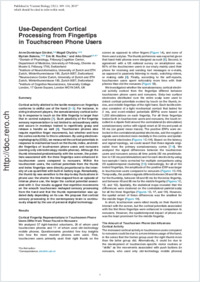Use-dependent cortical processing from fingertips in touchscreen phone users
- Gindrat, Anne-Dominique Domain of Physiology, Fribourg Cognition Center, Department of Medicine, University of Fribourg, Switzerland
- Chytiris, Magali Domain of Physiology, Fribourg Cognition Center, Department of Medicine, University of Fribourg, Switzerland - Institute of Neuroinformatics, University of Zurich and ETH Zurich, Switzerland
- Balerna, Myriam Domain of Physiology, Fribourg Cognition Center, Department of Medicine, University of Fribourg, Switzerland - Institute of Neuroinformatics, University of Zurich and ETH Zurich, Switzerland
- Rouiller, Eric M. Domain of Physiology, Fribourg Cognition Center, Department of Medicine, University of Fribourg, Switzerland
- Ghosh, Arko Institute of Neuroinformatics, University of Zurich and ETH Zurich, Switzerland - Neuroscience Center Zurich, University of Zurich and ETH Zurich, Switzerland - Institute of Cognitive Neuroscience, University College London, UK
-
05.01.2015
Published in:
- Current Biology. - 2015, vol. 25, no. 1, p. 109–116
English
Cortical activity allotted to the tactile receptors on fingertips conforms to skilful use of the hand [1, 2 and 3]. For instance, in string instrument players, the somatosensory cortical activity in response to touch on the little fingertip is larger than that in control subjects [1]. Such plasticity of the fingertip sensory representation is not limited to extraordinary skills and occurs in monkeys trained to repetitively grasp and release a handle as well [4]. Touchscreen phones also require repetitive finger movements, but whether and how the cortex conforms to this is unknown. By using electroencephalography (EEG), we measured the cortical potentials in response to mechanical touch on the thumb, index, and middle fingertips of touchscreen phone users and nonusers (owning only old-technology mobile phones). Although the thumb interacted predominantly with the screen, the potentials associated with the three fingertips were enhanced in touchscreen users compared to nonusers. Within the touchscreen users, the cortical potentials from the thumb and index fingertips were directly proportional to the intensity of use quantified with built-in battery logs. Remarkably, the thumb tip was sensitive to the day-to-day fluctuations in phone use: the shorter the time elapsed from an episode of intense phone use, the larger the cortical potential associated with it. Our results suggest that repetitive movements on the smooth touchscreen reshaped sensory processing from the hand and that the thumb representation was updated daily depending on its use. We propose that cortical sensory processing in the contemporary brain is continuously shaped by the use of personal digital technology.
- Faculty
- Faculté des sciences et de médecine
- Department
- Département de Médecine
- Language
-
- English
- Classification
- Biological sciences
- License
- License undefined
- Identifiers
-
- RERO DOC 235562
- DOI 10.1016/j.cub.2014.11.026
- Persistent URL
- https://folia.unifr.ch/unifr/documents/304212
Statistics
Document views: 59
File downloads:
- rou_udc.pdf: 170
